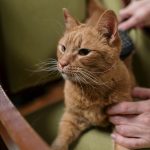You’ll find polypropylene upholstery holds up well against your cat’s claws thanks to its tough, tightly woven fibers that resist snagging and tearing better than many fabrics. While no material is entirely scratch-proof, polypropylene handles everyday clawing, moisture, and stains with ease. If you want to keep your furniture looking great longer, you can take steps to protect it and explore other pet-friendly options that combine durability with comfort. There’s plenty more to contemplate for lasting furniture care.
Table of Contents
Key Takeaways
- Polypropylene upholstery is highly resistant to cat claw scratches and tearing due to its tightly woven, durable synthetic fibers.
- While polypropylene resists everyday clawing, persistent scratching from cats can eventually cause damage or loosen threads.
- Polypropylene repels moisture and odors, helping furniture stay fresh despite cat interactions like kneading or rubbing.
- Regular nail trimming and providing scratching posts can significantly protect polypropylene furniture from claw damage.
- Using deterrent sprays, furniture protectors, or slipcovers further enhances polypropylene’s durability against cats.
Understanding Polypropylene Fabric and Its Properties
Polypropylene fabric has become a popular choice for upholstery, especially in homes with cats. You’ll find it’s a synthetic material known for its durability and resistance to stains, moisture, and fading.
Because it repels water and resists many chemicals, it’s easier to clean compared to natural fibers. You’ll appreciate its lightweight nature and ability to maintain shape over time, even under frequent use.
Plus, polypropylene is less likely to absorb pet odors, which keeps your furniture smelling fresher. However, it’s important to note that while it resists everyday wear, the fabric can be vulnerable to sharp objects.
Understanding these properties helps you decide if polypropylene matches your lifestyle and pet’s behavior without compromising your upholstery’s longevity.
How Cats Interact With Upholstery Fabrics
Although cats bring joy and companionship, their natural behaviors can challenge your upholstery’s durability. You’ll notice they often interact with fabrics in ways that test their strength.
Cats use upholstery for:
- Scratching to sharpen and maintain their claws.
- Climbing and jumping, putting stress on fabric fibers.
- Kneading, which can loosen threads over time.
- Marking territory through rubbing and scent glands, causing wear and stains.
Understanding these behaviors helps you anticipate potential damage and choose fabrics wisely.
Recognizing feline habits allows you to protect your upholstery and select durable, pet-friendly fabrics.
While cats don’t aim to ruin furniture, their instincts can lead to tears or fraying. By recognizing how your cat interacts with upholstery, you can better protect your investment and maintain a pet-friendly home environment without sacrificing style or comfort.
The Resistance of Polypropylene to Cat Claws
When your cat sinks its claws into fabric, you want materials that can stand up to the challenge. Polypropylene is known for its toughness and resilience, making it a solid choice against scratches. Its tightly woven fibers resist snagging and tearing better than many natural fabrics. However, no material is completely immune to persistent clawing.
Here’s a quick look at how polypropylene holds up compared to other fabrics:
| Fabric Type | Scratch Resistance | Durability Against Claws |
|---|---|---|
| Polypropylene | High | Strong |
| Cotton | Low | Weak |
| Linen | Medium | Moderate |
| Leather | Medium | Moderate |
| Wool | Low | Weak |
Choosing polypropylene means you’re opting for a fabric that’s naturally tougher against your feline’s claws.
Tips to Protect Polypropylene Upholstery From Cats
If you want to keep your polypropylene upholstery looking great despite your cat’s playful scratches, there are effective steps you can take.
Protecting your furniture involves redirecting your cat’s scratching habits and creating barriers.
- Place scratching posts nearby to satisfy their natural urge.
- Use furniture protectors or slipcovers that resist claws.
- Apply a cat-safe deterrent spray on the upholstery.
- Keep your cat’s nails trimmed regularly to minimize damage.
Alternatives to Polypropylene for Cat-Friendly Furniture
Protecting polypropylene upholstery from cat scratches can help, but you might want to explore other fabric options that naturally stand up better to your cat’s claws.
Consider microfiber or tightly woven fabrics like canvas or denim—they’re durable and less prone to snagging. Leather and faux leather are also great choices since their smooth surface discourages scratching and is easy to clean.
Another excellent option is Crypton fabric, designed to resist stains and damage, making it pet-friendly.
When choosing, avoid loosely woven or delicate materials like velvet or silk, which cats can easily tear.
Selecting these alternatives can save you time and money on repairs while keeping both your furniture and your feline friend happy.
Frequently Asked Questions
Can Polypropylene Fabric Cause Allergies in Cats?
You shouldn’t worry much—polypropylene fabric rarely causes allergies in cats. However, if your cat shows itching or redness, it might be sensitive. Always watch for reactions and consult your vet if symptoms persist or worsen.
Is Polypropylene Upholstery Safe if Cats Chew on It?
Think of polypropylene upholstery as a fortress; it’s generally safe if your cat chews it, but ingesting bits can cause digestive troubles. You should discourage chewing to keep your feline friend healthy and your furniture intact.
How Does Polypropylene Compare to Leather Against Cat Damage?
You’ll find polypropylene resists scratches better than leather, which cats can easily claw and puncture. However, polypropylene may show some wear over time, while leather can develop appealing patina but also deep damage.
Are There Specific Polypropylene Weaves Better for Cats?
You should choose tight, dense polypropylene weaves like microfiber or canvas for better resistance against cat claws. These weaves reduce snagging and tearing, helping your upholstery last longer despite your cat’s playful behavior.
Does Washing Polypropylene Upholstery Affect Its Durability With Cats?
Back in the days of dial-up, you’d worry less—washing polypropylene upholstery can actually help maintain its durability against your cat’s claws. Just avoid harsh detergents, and your fabric stays tougher and fresher longer, ready for battle.
- Velvet Fabric in Arabic: Terminology & Cultural Context - June 22, 2025
- Best Fabric Paint for Velvet: Product Recommendations & Application - June 22, 2025
- Velvet Upholstery Fabric Content: Typical Fiber Blends & Performance - June 22, 2025






